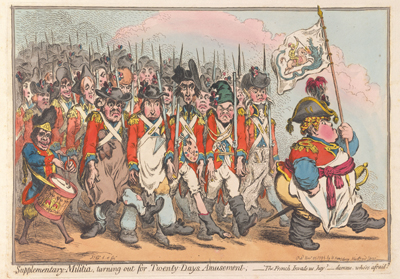Supplementary-Militia, Turning-Out for Twenty Days Amusement
In 1793, when France declared war upon Britain and Holland, the British militia numbered approximately 45,000. But by 1796 when the war was still proceeding and the threat of a French invasion was growing stronger, Pitt introduced a Supplementary Militia Act to add 60,000 more troops to protect the homeland. Each parish was required to provide a list of eligible men. From that list a ballot was then created to select those who would serve. The troops were given 20 days of training each year to help establish and maintain their fighting skills.

© Beinecke Rare Book and Manuscript Library, Yale University
But since a balloted man could get out of service with a £10 fine or by finding a substitute, most of the militia was composed of men who had neither the wealth to pay the fine nor the power and influence to find a substitute. Consequently, in Gillray's Supplementary-Militia, Turning-Out for Twenty Days Amusement, he shows a force composed mostly of tradesmen, including a shoemaker, a bricklayer, a tailor and a hairdresser, all led by a stout butcher carrying a brave flag showing St George defeating the dragon. As in his later St George's Volunteers Charging Down Bond Street, (1797) Gillray portrays the marchers forming a humorously incongruous group. But as he so often does when war is part of the subject matter, Gillray also injects a distinctly ironic note with the presence of the peg-legged drummer. Purposely made smaller and set somewhat apart from the main line of troops, the drummer reminds one that war is not finally amusement, and that the bravado of the caption "The French invade us, hay?—damme, whose afraid?" may be naive.
There is still a figure we haven't talked about. And that is the artist in the center of the print. Like the other troops identified by the implements of their profession, Gillray shows the artist with his easel and brushes and further identifies him with the initials "R.A." as a member of the Royal Academy of the Arts. But by placing him in the same line as the tradesmen, and portraying him as even poorer and more emaciated than his companions, Gillray adds a no doubt feeling comment about the status of the arts in Britain and the precariousness of an artist's life.
Without much justification, the artist in Gillray's print has been traditionally identified as the painter and member of the Royal Academy, John Hoppner. But as Draper Hill notes in his commentary on this print, Hoppner "was neither ugly nor impoverished." Indeed, Hoppner was both wealthy and successful at court, with commisions including the Prince of Wales, the Duke and Duchess of York, and Lord Nelson.
A more likely candidate, I would suggest, is another member of the Royal Academy, Francis Wheatley who had been declared insolvent in 1793 and who struggled to make ends meet until his death in 1801 when his funeral expenses were paid for by the Royal Academy. Earlier in his career, Wheatley had produced several paintings featuring the militia, including The Riot in Broad Street(~1790) and The Dublin Volunteers on College Green, 4th November 1779 (1780). So it's possible that Wheatley was, in fact, a member of the militia or that Gillray was aware of the paintings and associated Wheatley with the military. Wheatley was certainly on Gillray's mind around this time. As I have argued in my commentary on Sandwich-Carrots! Dainty Sandwich-Carrots published ~9 days after Supplementary Militia, Gillray was clearly responding in that print to Wheatley's series, Cries of London, using a vendor-buyer situation like Wheatley's and mimicking Wheatley's sing-song titles—"New Mackerel, New Mackerel," "Sweet China Oranges, Sweet China," and "Strawberrys, Scarlet Strawberrys."
Sources and Reading
- Commentary from the British Museum on Supplementary-Militia, Turning-Out for Twenty Days Amusement.
- Draper Hill, The Satirical Etchings of James Gillray, 1976, #43.
- "British Volunteer Corps," Wikipedia
- "Militia (Great Britain)," Wikipedia
- Cecil Sebag-Montefiore, A History of the Volunteer Forces from the Earliest Times to the Year 1860, 1908
- "Wheatley's Cries of London" Spitalfields Life
- Thomas Wright and R.H. Evans, Historical and Descriptive Account of the Caricatures of James Gillray #133
- Thomas Wright and Joseph Grego, The Works of James Gillray, the Caricaturist; With the History of His Life and Times, p. 206
Comments & Corrections
NOTE: Comments and/or corrections are always appreciated. To make that easier, I have included a form below that you can use. I promise never to share any of the info provided without your express permission.